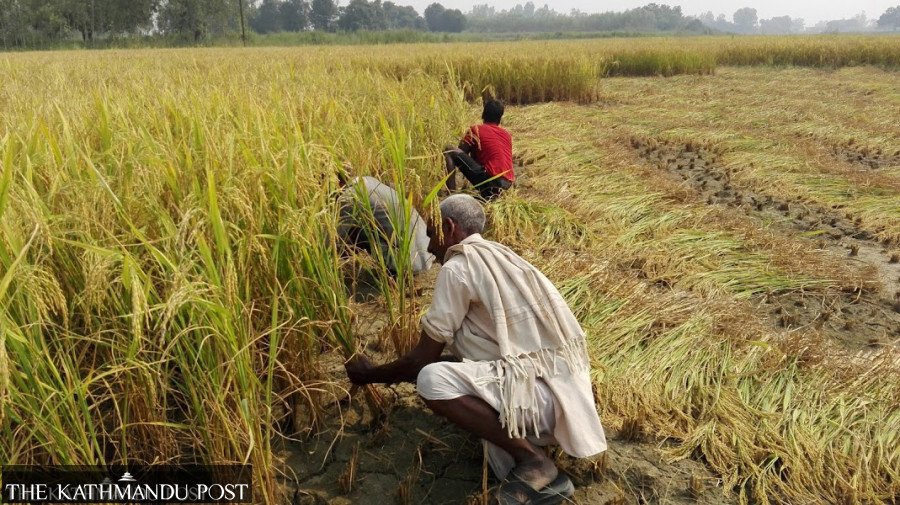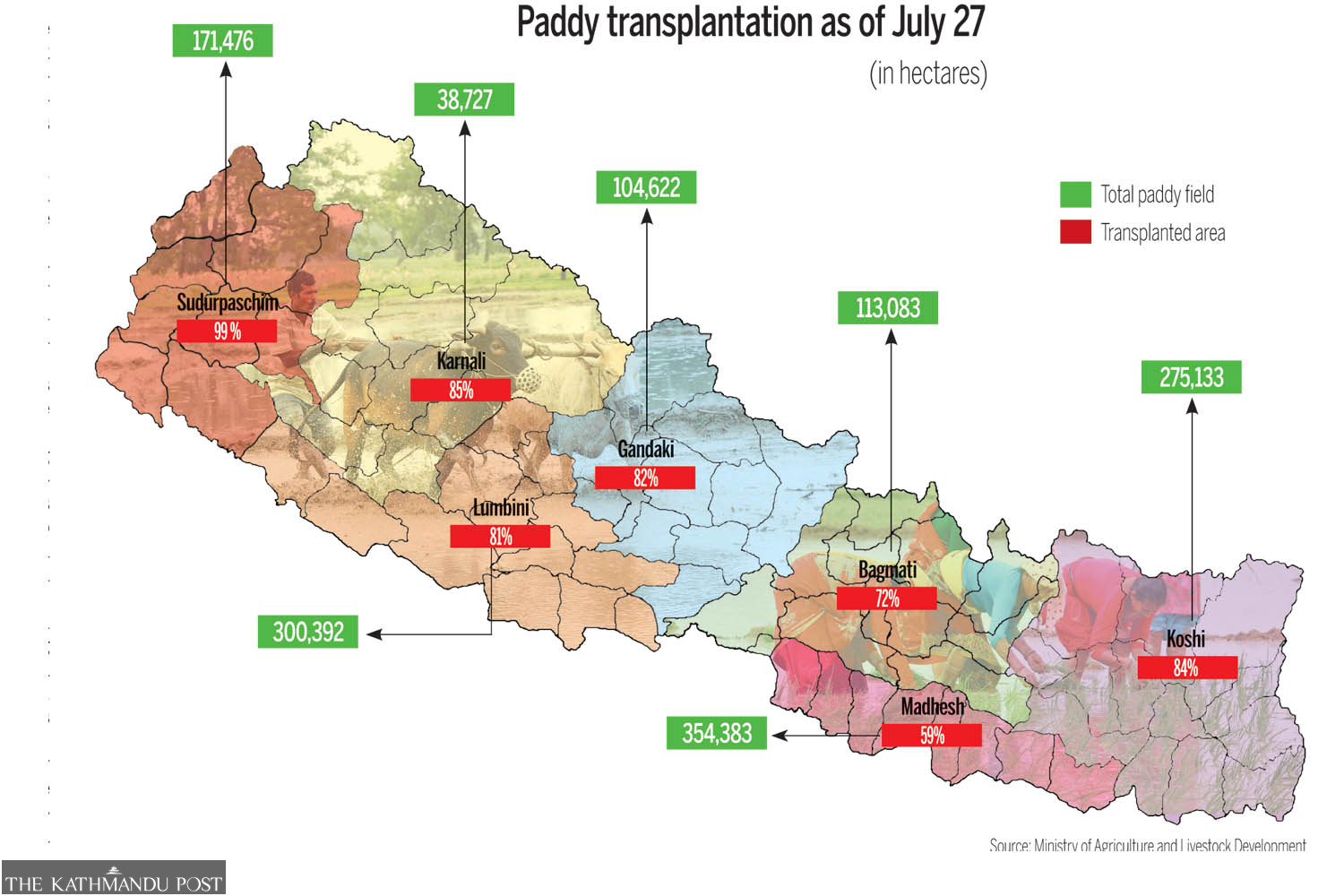Money
Fear of food crisis as multiple problems hit paddy production
Lumpy skin, low monsoon rainfall and slow transplantation have raised possibility of a reduced harvest, experts say.
Sangam Prasain
Nepalis fear a possible food crisis as a bunch of problems threaten to disrupt the supply of the country's staple grain, rice.
The lumpy skin disease, which has killed thousands of oxen, low monsoon rainfall and slow pace of paddy transplantation have raised the possibility of a reduced paddy harvest, experts say.
India's announcement of an export ban on non-basmati rice has not helped to assuage supply concerns as Nepal imports rice from the southern neighbour to fill gaps in its inventory.
Paddy transplanting work across the country has slowed due to a weak monsoon as farmers depend on the heavens for water to grow their crops.
Work also slowed because they have not been able to plough fields with the lumpy skin disease decimating their cattle. Early projections show a disappointing harvest this year.
Amid the gloomy outlook, India has announced an embargo on all non-basmati rice varieties to keep its food reserve intact.
Experts say that if Nepal fails to introduce a proper action plan to minimise the multiple shocks—ranging from drought, price spikes and cattle disease to heat waves—the situation could turn catastrophic.
“The worst may be coming,” said agriculture economist Devendra Gauchan.
Nepal has been facing multiple crises since the Covid pandemic. Post-Covid, food prices soared due to supply restrictions and the annual inflation rate rising to nearly 8 percent.
By the beginning of Nepal’s paddy transplantation period in June, the lumpy skin disease had become widespread, killing more than 50,000 head of cattle across the country. The total direct losses have been estimated at over Rs40 billion.
“Oxen are used to prepare the land for transplanting paddy in Nepal. During the critical transplanting period, thousands of cattle were sickened and killed by diseases.
This will impact paddy production,” said Gauchan.
The El Niño climate event, which is caused by warmer surface waters in the Pacific Ocean, leads to an increased risk of heavy rainfall and droughts in certain parts of the world. El Niño did not spare Nepal.
According to the statistics of the Ministry of Agriculture and Livestock Development, paddy had been transplanted on 77 percent of the 1.35 million hectares of available paddy fields as of July 28.
In the same period last year, transplantation had been completed on 90 percent of the total cultivable land.
The transplantation rate is at a multi-year low, mainly as a result of low rainfall. The current transplantation rate points to the possibility of a reduced harvest.
Rice is the staple food for millions of Nepalis and a major driver of the economy.
Paddy is Nepal’s biggest earning farm commodity, with tens of thousands of farmers relying on its income. The low output, according to economists, may cause further upward pressure on inflation and downward pressure on the economy.
The country possesses 1.35 million hectares of land suitable for growing paddy. The grain is generally planted twice a year—in June and February. However, spring paddy in February is planted on only 112,000 hectares.
“The transplantation rate initially was affected by the lumpy skin disease across the country. Then the low rainfall slowed progress,” said Januka Pandit, deputy director general at the Department of Agriculture.
“It’s already late, but we still have time to recover,” said Pandit, an agriculture economist. She says that if there is good rainfall from now onwards, the harvest may be good. “But no one knows what will happen.”
Gauchan said that if the drought continues for two more weeks in the key food-producing areas, Nepal may experience a big output loss.
Nepali farmers harvested 5.48 million tonnes of paddy in the last fiscal year, 7 percent more than the previous fiscal year's harvest.
With India announcing a ban on non-basmati rice export and given the current weather phenomenon in Nepal, there may be a food crisis for a short period, say experts. But the repercussions would be huge, they say.
“It’s a national agenda and should be dealt with tactfully,” said Pandit.
India’s export ban on non-basmati rice will significantly impact the poor people who can't afford to eat basmati rice. “The ban has prompted price spikes globally. In Nepal too, prices are already up,” said Gauchan.
Most Nepalis eat rice in the morning and rice in the evening to meet their nutritional needs. Experts say a supply deficit of even 2-3 percent can send market prices soaring.
Paddy transplantation normally extends until mid-August in the Tarai, the country’s grain basket. In some places, paddy is planted till September when farmers sow the seeds directly instead of transplanting seedlings if the low rainfall pattern prevails.
A delay in transplantation means the harvest will extend till the winter.
Paddy, being a semi-aquatic crop, has been known to grow well in good rainfall and sunlight. If the harvesting is delayed or advanced, a decline in rice production will be inevitable. Besides, it will affect the cycle of the subsequent winter crops.
This year, the monsoon entered Nepal on June 14, a day after the normal onset date.

The Tarai contains 71 percent of the country's rice fields. The hilly region has 25 percent and the mountain region 4 percent.
According to the ministry, this year, the transplantation rate is higher in Sudurpaschim province in far western Nepal, with 99 percent of the total 171,476 hectares planted.
The transplantation rate in Karnali province has been recorded at 85 percent of the total 38,727 hectares.
In Lumbini province, farmers had finished transplanting paddy on 81 percent of the 300,392 hectares, slightly below the 85 percent figure in the same period last year.
Gandaki province observed a paddy transplantation rate of 82 percent of the 104,622 hectares, way below the rate last year, which was 96 percent.
The transplantation rate in Bagmati province, too, has slowed. As of July 28, transplantation had been completed on only 72 percent of the 113,083 hectares. In the same period last year, the rate was 93 percent.
Madhesh province is the most affected among the provinces. The ministry's statistics show that paddy transplantation in Madhesh, with 354,383 hectares of paddy fields, reached a meagre 59 percent. In the same period last year, transplantation was completed on 89 percent of the fields.
Paddy transplantation in Koshi province has been completed on 84 percent of the total 275,133 hectares. The rate was 88 percent in the same period last year.
On July 20, Nepal’s southern neighbour ordered a halt to rice exports triggering fears of further inflation in global food markets. The impact of the export ban has become visible in Nepal.
Diwakar Neupane, proprietor of Neupane Kirana Store at Kumarigal, said he had been selling a common rice variety at Rs2,100 per bag until last week.
“The wholesaler has increased the price to Rs2,300 per bag. People nowadays often ask about prices.”
Nepal requires 4 million tonnes of rice annually to feed its population, and the deficit is made up by imports from India.
According to the Department of Customs, cereal imports from India were valued at Rs56.62 billion in the last fiscal year.
Nepal imported 174,120 tonnes of non-basmati rice worth Rs10.78 billion from India alone in the last fiscal year. Imports of Basmati rice totalled 48,569 tonnes worth Rs4.63 billion.
Similarly, the import of paddy from India amounted to 555,869 tonnes worth Rs19.99 billion in the last fiscal year ended mid-July.




 6.84°C Kathmandu
6.84°C Kathmandu















